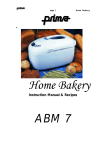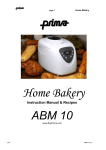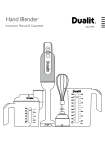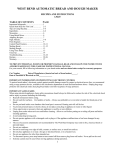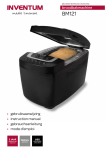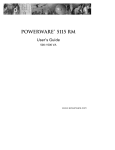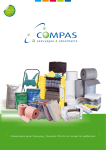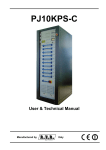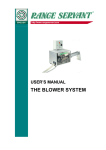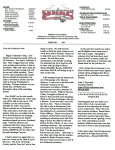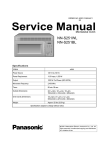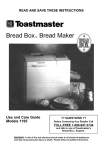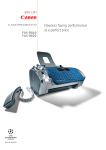Download Prima ABM 9 User's Manual
Transcript
page 1 Home Bakery . Home Bakery Instruction Manual & Recipes ABM 9 www.prima-international.com page 2 Home Bakery Use your loaf! Please read the instructions START HERE ! INTRODUCTION Your Prima Home Bakery is the result of Prima’s many years of experience with bread making machines. Whether you have never made bread before or if you have made your own bread for years, the information in this booklet is essential if you are to obtain the best from your machine. There are a number of key differences between manual bread making and machine bread making. It is best to approach the subject without any pre-conceived ideas or expectations. This book has been designed to ensure that you get outstanding results right from the first loaf you make. There are a number of recipes included, which use all the various programmes and functions of the machine. These recipes have been designed to give you an instinctive feel for the machine. This will create a pattern of success that will eventually lead to your adapting or creating your own recipes. Indeed, you will probably find that most other recipes are variations of those found within this book. page 3 Home Bakery PLEASE KEEP THE BOX AND PACKAGING THE PACKAGING IS SPECIALLY DESIGNED TO TRANSPORT THE APPLIANCE SAFELY. IF YOU EVER NEED TO RETURN THE UNIT FOR A SERVICE IN THE FUTURE THERE IS A GOOD CHANCE IT WILL ARRIVE DAMAGED IF ANY OTHER TYPE OF PACKAGING IS USED. • Important safety information. Please read & retain for future reference. • Please read through all the instructions before using the bread maker. • Be sure to use suitable mains supply 220-240V ~ AC • DO NOT touch hot surfaces during operation. • DO NOT allow children to operate this machine unsupervised. • NEVER place hands/fingers into the bread pan whilst the machine is in use. • DO NOT immerse plug, cord or base in water or other liquids. • DO NOT use the bread maker outdoors • KEEP the bread maker at least 50mm away from walls or any other objects when in use. • ALWAYS unplug the appliance when not in use or before cleaning. • ALWAYS use on an even surface & check that the rubber feet have a secure grip. • DO NOT allow power cord to hang over edge of counter or work surface. • ALWAYS use two hands when moving the machine. • CLEAN the outside of the bread maker with a damp cloth only. The bread pan should be cleaned after each use with mild detergent solution, rinsed and dried thoroughly. • IF the unit is dropped or becomes damaged in any way, do not use but call Prima Service first (number at back of book). THIS APPLIANCE IS FOR HOUSEHOLD USE ONLY PLEASE SAVE THESE INSTRUCTIONS page 4 Home Bakery page • ABOUT BREAD 5 Home Bakery 1 Bread is one of the oldest foodstuffs we know. Soon after humans first learnt to plant seeds, bread became the staple food of many cultures world wide. Since then each culture has developed it’s own method of making bread using local ingredients and processes unique to them. This trend continues today. Even pre-packed supermarket bread differs in taste and texture from country to country. No matter how varied the range of breads on offer in bakers shops or supermarkets, there is nothing quite like the warm fragrance and taste of fresh home-made bread. Just a few of the ingredients available from local shops & supermarkets page 6 • ABOUT BREAD MAKERS Home Bakery 2 With the continued success of the Prima Home Bakery it is nice to know that technology is actually helping to preserve the art of home bread making for generations to come. Like most kitchen appliances, your bread maker is a laboursaving device. The principal benefit is that all the kneading, rising and baking is performed within a space saving, selfcontained unit. Your Prima Home Bakery will easily produce superb loaves time and again provided the user follows the instructions and understands a few basic principles. Unless you enjoy eating breezeblocks, it is not wise to expect the machine to think for you. It cannot tell you that you’ve forgotten the yeast or that the flour was the wrong type or measured incorrectly. Prima ABM9 page • INGREDIENTS 7 Home Bakery 3 The most important part of the bread making process is the wise selection of ingredients. You and your Prima Home Bakery will produce outstanding results with the right ingredients. Just apply this simple rule: Best ingredients - best results, poor ingredients - poor results. For example; if good yeast, good flour and cold water were thrown together and mixed in an old bucket the mixture would still rise! Nothing the bread maker does will prevent the dough from rising so if your loaf does not rise it is most unlikely that the bread maker is to blame. It is probably due to the ingredients. In order to save you time we have included information on each major element used in the making of bread which will enable you to obtain perfect results first time every time. See the appendix at the end of this book for a list of suppliers of quality ingredients. • FLOUR 4 In bread making the most important element in the flour is the protein called gluten, which is the natural agent that gives the dough the ability to hold its shape and retain the carbon dioxide produced by the yeast. The term ‘strong flour’ means that it has a high gluten content. It has probably been milled from hard wheat and is particularly suitable for bread making. In the UK the taste and gluten content of flour varies with each brand. At Prima we use Allinsons Strong White, Strong Brown or Wholemeal flour for product testing because it gives consistently good results. Other good brands are Sainsbury’s own brand, Hovis bread machine flour or McDougals strong white flour. Safeway’s own brand of bread flour is also quite good. You may wish to approach your local mill for flour. If you do, be sure to specify that you require a fine ground flour with a high protein content if you want light well-risen loaves. See the appendix at the end of this book for suppliers of good quality flour. page • 8 Home Bakery BROWN FLOUR (or FARMHOUSE FLOUR) 5 Brown flour contains about 85% of the wheat kernel. Much of the bran part of the wheat kernel has been removed. Loaves made with all brown flour tend to be smaller than white loaves due to the lower gluten content but there tends to be more flavour and texture to brown loaves. When buying this type of flour the strong, finely ground type will give better results in the bread maker. • WHOLEMEAL OR WHOLE-WHEAT FLOUR 6 This type of flour contains all of the original wheat kernel including the bran; the tough outer skin of the wheat which is an excellent source of fibre. As with the brown flour, you should specify a strong fine ground variety when using your bread maker. The bran in the wholemeal flour inhibits the release of gluten so wholemeal loaves tend to be smaller and more dense than white loaves. However, the flavour is superb (try the honey wholemeal recipe). Your Prima Home Bakery has a special process for wholemeal bread, which devotes more time to the kneading and rising processes. • YEAST 7 Yeast is the living organism that multiplies in the dough. It produces the carbon dioxide bubbles that make the dough rise. For bread making machines it is best to use the ‘Easy Blend’ dried yeast that comes in sachets. This yeast does not rely on sugar in order to ferment so it is easier to reduce the sugar content of your loaf without any adverse effects. Good brands of dried yeast are Homepride, Sainsbury’s, Hovis (7g sachet) or McDougals. Other supermarket own brands also give satisfactory results. Avoid yeast in tubs or tins as these tend to perform less well once opened. Sachet yeast is very sensitive to moisture so do not store part used sachets for more than a day. page 9 Home Bakery • SALT 8 Salt adds to the flavour of the bread of course but it can also be used to slow down a particularly lively yeast. • BUTTER (or fat) 9 Enhances the flavour and makes the loaf softer. Alternatives to butter are margarine or olive oil. Avoid low fat spreads as these may be as little as 40% fat and will not have the same effect. • SUGAR 10 Sugar adds to the flavour of the bread and goes some way to making the crust go brown. Note: Most sachet yeasts do not rely on sugar to become active. • WATER 11 Use soft water if you can but your Prima Home Bakery will still make good bread with hard water. There is often much debate on what temperature the water should be. The answer is simple. If you put your hand in the water and it feels cool then it’s fine. There is no need to warm the water first. If you’re worried the water may be too cold from the tap just leave it to sit for an hour in the kitchen before you use it. Making the water warm could kill the yeast prematurely. The Prima Home Bakery takes the guesswork out of bread making. • OTHER INGREDIENTS 12 Other ingredients could mean anything from dried fruit, cheese, eggs, nuts or yoghurt to other cereals like rye flour, corn meal or any number of herbs and spices. It’s up to you. There are a couple of things to consider for best results. Always be aware Cont. of the moisture content and adjust accordingly. page 10 • OTHER INGREDIENTS Home Bakery cont. Things like cheese, milk and fresh fruit contain quite a lot of water, which will determine the look of the finished loaf. At first you can stick to dry substitutes like Parmesan cheese, dried milk or dried fruit. As you become more proficient with the machine you will instinctively know whether the dough looks too wet or too dry and can add flour or water during the process. Remember to consider the salt content of the ingredients you add. Salt can slow down the yeast. Finally, as a rule of thumb, if the added ingredients are wet like yoghurt or powdered like dried herbs they can go into the mixture at the start of the process. For things like nuts or dried fruit there is a time during the process where the machine will beep to let you know it’s time to add these to the dough mixture. Refer to the CYCLE TIME table so you know when to expect the beep. • ENVIRONMENT 13 Last but not least of the ingredients is the environment in which the bread is made. The Prima Home Bakery will work well in a wide range of temperatures but there could be a difference of 15% in loaf size between a very warm room and a very cold room. Do not site your bread maker in a draughty part of the house. The machine will offer some protection to the dough against draughts but it does have limits. If the humidity in the room is high this too could affect the loaf. As a general rule, if the room is comfortable for you it will be comfortable for your bread maker. • STORING YOUR BREAD 14 Homemade bread contains no artificial preservatives. However, if you store the bread in a clean, air-tight container in the refrigerator it should keep for 5-7 days. The bread is also good to freeze but allow finished loaves to go cold before placing into a polythene bag and storing in the freezer. page • 11 Home Bakery CHECK THE ACCESSORIES 15 At this point it might be a good idea to familiarise yourself with the bread maker and setting the controls. When you unpack your Home Bakery you should have the following items: 1 kneading blade 1 measuring cup. You can use this cup for measuring the liquid ingredients or you can use your own measuring jug as long as it’s graduated in ml. 1 measuring spoon. The quantities of sugar, oil & some other ingredients in these recipes are based upon this metric tablespoon (15ml – large end) and metric teaspoon (5ml – small end) Get Familiar! Open the lid & familiarise yourself with removing & replacing the bread pan. Note that the pan must be properly inserted into the machine before the drive cog can make proper contact with the kneading shaft. 1. To remove the pan from the machine turn it anticlockwise then lift out by the handle 2. To insert the bread pan, place it into the baking chamber and turn it clockwise Next, insert the kneading blades. As you place them over the kneading shaft, rotate them until they lock into place. page • THE CONTROLS 12 Home Bakery 16 START/STOP button. Starts the programme (of course). To stop the programme part way through you need to press and hold this button for 3 seconds. After which, the machine will reset to programme 1 (NORMAL). Time selector. For use when setting the delay timer (see section of timer operation) Crust control. Press to select crust colour between light, medium & dark. Note: Crust control is not available in all modes. PROG. Main selector control. Press to cycle through each programme. The programme number is shown on the display. Display. Shows time remaining. The dots flash when the programme is running. NOTE: if display reads H:HH it means the machine is too hot to make another loaf. You’ll need to wait for it to cool down. Programme Indicators. Illuminate depending upon which programme is selected. page 13 • THE PROGRAMMES Home Bakery 17 Please see below a summary of all the modes/programmes. DISPLAY FUNCTION 1. NORMAL. This is a good, general-purpose programme for white or brown bread. Most of the recipes use this programme. 2. RAPID bread setting. Uses shorter steps to make bread in a shorter time. Loaves made in this mode are usually smaller and more dense. 3. FRENCH. This setting is slightly longer than the NORMAL programme due to the extra kneading and rising time required to give the loaf an ‘airy’ texture characteristic of French bread. (Does not come out in sticks!) 4. QUICK. This mode is similar to the RAPID programme in that the steps are shorter for a faster process time. Quick mode is good for the gluten-free recipes or pastry. 5. WHOLE WHEAT. This mode spreads the kneading and rising steps to give better results with the low gluten content whole wheat/whole meal flour. 6. CAKE. Programme for making cakes. 7. DOUGH. Performs all the steps of kneading and rising but omits the bake cycle. Note: Crust colour control is not available. If your dough turns out to be crusty, you’ve gone very wrong somewhere! 8. BAKE. Stand-alone bake cycle. Good for baking pre-made dough etc. Page 14 Home Bakery CYCLE CHART FOR MODEL ABM7 – all figures in hours/minutes BASIC 2LB 1.5LB 3:30 3:20 PREHEAT Motor is idle 20 17 QUICK 1:58 FRENCH 3:50 RAPID 1:52 5 22 3 W/WHEAT 2LB 1.5LB 3:40 3:30 40 37 CAKE 2:00 DOUGH 1:50 BAKE 1:00 JAM 1:00 Skip 22 Skip 15 45+ (heater on) Idle 20 (heater off) BREADMIX 2LB 1.5LB 3:20 3:09 22 11 STIRRING 3 3 3 3 3 3.5 3 Skip KNEAD 1 2 2 2 2 2 20.5 2 Skip KNEAD 2 Heater at 25°°c 13 Fruit signal at 2:57 (2lb) 2:50 (1.5lb) 20 Fruit signal at 1:33 16 Fruit signal at 3:12 5 No fruit signal 13 Fruit signal at 2:47 (2lb) 2:37 (1.5lb) Skip 16 Skip N/A 45 Skip 45 Skip 45 Skip Skip Skip N/A 45 RISE 2 19 7 26 7 19 Skip 45 Skip N/A 19 RISE 3 46 26 51 27 36 Skip 22 Skip N/A 40 55 65 65 80 plus 16 mins idle time Skip 60 N/A 56 60 60 60 Skip 60 Skip Skip 60 N/A 60 13HR N/A 13HR N/A 13HR N/A 13HR 13HR N/A 13HR RISE 1 Heater on/off @ 25°°C BAKE KEEP WARM Not incl’d in total time TIMER 62 55 62 55 3 2 13 Fruit signal at 2:45 - both loaf sizes Page • 15 HOW TO USE THE TIMER Home Bakery 19 The most common use for the timer is to make a loaf overnight so it will be ready in the morning. Many people also programme the timer so the loaf is ready when they get home from work. However you use the timer, it’s a lot easier to set than most video recorders! Once you have selected your desired programme, simply press the TIMER (up) button on the control panel and the figure on the display will increase by 10 minutes. This way you can delay the end of the programme to suit your requirements. The important thing to remember is that whatever the display reads is the time from pressing START to when the loaf will be ready. For example: After selecting the required programme, if you keep pressing the TIMER button until the display reads 5:00 then press START it will be 5 hours before the loaf is ready. If you press the TIMER (up) button some more and the display reads 8:10 then (you’ve guessed it) the loaf will be ready in 8 hours and 10 minutes. To save wear & tear on your index finger you can press & hold the TIMER (up/down) buttons to scroll quickly to your desired setting. NOTES: • The maximum time you can select is 13:00. • Once you have pressed START you cannot alter the timer. • If you need to reset the timer press START/STOP button for 3 seconds and the machine will reset, after which you can re-select your programme and delayed time accordingly. NB. You should not do this if the process is past the first kneading. • Do not use perishable ingredients like milk or eggs when using the delay timer as these will spoil whilst sitting in the bread pan. • You cannot reduce the delayed time to less than the process time. Page • 16 Home Bakery YOUR FIRST LOAF 20 Before we start, if you have skipped forward to this part of the book and not read the preceding pages like the rest of us then shame on you! You may be about to waste some flour! The following recipe is for a basic white loaf. Even if you do not usually eat white bread we strongly recommend you make this as your first loaf because it is easiest. It will give you a good feel for the machine and when you remove your perfect loaf you’ll want to show it off to your friends or relatives who invariably waste no time at all in eating it! You will need the following ingredients to hand: Water Strong white bread flour Butter or margarine Sugar Salt Yeast (sachet type) 2½ 250ml 460g 2tbps 2tbsp 2 tsp (NOT tbsp!) tsp (usually 1 full 7g sachet) This will make a 1½ lb loaf Use good kitchen scales to measure the flour. Use the measuring cup provided for the liquid or, if you prefer, any measuring jug that’s calibrated in ml. Page YOUR FIRST LOAF 17 (METHOD) Home Bakery 20 Method 1. Remove the bread pan from the machine. 2. Put the ingredients into the pan in the order they are listed above 3. When it comes to adding the yeast, make a small well in the flour and pour the yeast granules into it. This keeps the yeast dry until the process starts. 4. Put the bread pan into the machine, turning it clockwise to lock it into place. Close the lid: NOTE: the machine won’t work with the lid up! 5. Press the ‘PROG’ button until the NORMAL programme indicator is lit 6. Press the START/STOP button to start the process IMPORTANT: The motor doesn’t start immediately. There is a warming period first. 7. When the process is complete the machine will beep. 8. Lift the lid of the machine, then, using oven gloves or a tea towel, turn the pan anti-clockwise and lift it out of the machine. 9. Turn the pan upside down and shake lightly until the loaf slides out. Place the loaf onto a wire tray or rack to cool. NOTES: The kneading blade may stay in the pan or it may come out in the loaf – If you need to remove the blade from the loaf, wait until the loaf is cool first. Make a small cut in the underside of the loaf and the blade should slide out. If the blade stays in the pan simply fill the pan with water, covering the blade. Leave it to stand for an hour. The blade should then be easy to remove. • HOW DID IT TURN OUT? 21 If you followed the steps on the previous page you should have a loaf that looks and tastes great. If not then the following information should help you identify what went wrong. If you have a failed loaf at any time in the future you can guarantee that the reason is here in these next few paragraphs. Page 18 • Frequently asked questions Home Bakery 22 PROBLEM CAUSE The motor did not run when I pressed START It’s not supposed to. All the programmes start with a pre-heat step that ensures all the ingredients are at the right temperature before the process starts. This is the signal to add other ingredients like fruit or nuts. Some of the recipes call for extra ingredients. Refer to the appropriate recipe for more information. The machine must be allowed to cool thoroughly before another loaf can be made. The machine will show the word H:HH on the display panel until it has cooled properly. The Keep Warm function prevents condensation from forming on the loaf after the bake cycle has finished. You can remove the loaf during the Keep Warm period then press START/RESET button to reset the machine. The machine will resume from where it left off as long as the power is restored within 30 minutes. After this, it is likely that the ingredients will have spoiled anyway. The machine beeped part way through the process. I tried to make another loaf straight after the first but the process wouldn’t start. What does the ‘keep warm’ sign mean when the loaf is finished? What if the power is interrupted accidentally during the process? • PROBLEMS? Sunken loaves. 22.1 Typically, what happens is the dough will rise very well then sinks just as the baking process starts. Most of the time, this is because the dough was not strong enough. Whilst the yeast is still producing gas, a weak dough will maintain a good shape but once the yeast is killed by the baking process, the loaf can sink under it’s own weight. 1. The mixture is too wet causing weak dough. a. Too much water/not enough flour. This will make the dough sloppy. The dough should be soft but firm. b. Use the recommended brands of flour and yeast at first. Other brands may need some adjustment to the ingredients. Some types of flour absorb less water than those recommended. In this case add an extra 50g of flour to make the dough thicker. c. You’re not using ordinary plain flour are you? It MUST say ‘for bread making’ on the packet. Page 19 Home Bakery • SUNKEN LOAVES cont. 22.1 2. The gas bubbles produced by the yeast are escaping! a. Remember the protein called gluten? (sec. 4). Dough without gluten is like water without soap; you cannot make bubbles in it. All the recommended white flour brands have sufficient gluten to make good dough. Other brands may not. If you are using whole meal, brown or bread flour from other sources, you may obtain better results with the WHOLE setting as this provides the extra kneading required to release the gluten. 3. The yeast is dead or has gone off. a. If you use warm water the yeast may be exhausted before the rising process is complete. Tap water is usually fine. Be extra careful that the yeast does not come into contact with the water before the mixing process starts. This is particularly important when using the timer. b. Check best before date on yeast sachet. If it is close to expiry it would be best to buy some more. c. Avoid using yeast from sachets that are already opened. Use a new sachet every time. • MY LOAF DID NOT RISE! 22.2 Many of the reasons why bread doesn’t rise are outlined above. But first, let us eliminate the obvious: a. Whole meal & brown loaves seldom rise as well as white. b. You did put the yeast in didn’t you? It’s easy to forget. c. A common error is mistaking teaspoons of salt for tablespoons. The yeast will not work well if you put too much salt in. d. Both the flour and the yeast must be in good condition. e. The mixture may have been too dry. Add 1-2 tablespoons of water to the mixture if necessary. f. If you feel that the yeast should be increased then only add an extra ½ tsp. • THE LOAF ROSE TOO HIGH AND STUCK TO THE LID! 22.3 Usually caused by too much yeast, too much water or flour, or forgetting to add the salt. Salt keeps the yeast in check – without it the yeast can cause the loaf to overrise. Remember: Nothing the machine does will prevent good dough from rising properly Page • 20 Home Bakery CLEANING 23 Bread Pan & Kneading Blade The most important thing when cleaning your Home Bakery is to keep the non-stick coating of the bread pan and kneading blade in good order. Never use metal utensils to remove loaves or cakes from the bread pan, as this will damage the non-stick coating. Avoid using strong detergents and don’t put the pan or kneading blades in the dishwasher. The strong detergent used in dishwasher tablets or liquids can damage the non-stick coating in the long term. If you can get away with just using water to clean the pan then just use water. After making a loaf a simple wipe round the pan with a damp cloth should be sufficient. If necessary, you can part fill the pan with water and leave it to soak for an hour (but no longer) to release any stubborn dough/bread fragments. After making a cake it is very likely that the bread pan will need to be soaked. However, avoid immersing the whole pan in water as this may damage the seals under the kneading blade shafts. The best method is to simply fill the pan with water, leave to soak for an hour then wipe round with a cloth. The oven Since most of the ingredients are loaded into the bread pan away from the oven it should not need to be cleaned too often. However, if you have an accidental spill or overflow, wait for the oven to cool completely then wipe round with a damp cloth moistened with a mild detergent solution then wipe dry. The Machine A simple wipe with a cloth moistened in a mild detergent solution should be sufficient. IN ALL CASES ALWAYS ENSURE THAT THE MACHINE IS COLD AND DISCONNECTED FROM THE MAINS SUPPLY BEFORE CLEANING Page • RESOURCES 21 Home Bakery 24 Barbara’s Kitchen For further information about the Gluten Free recipes used in this book contact: Barbara’s Kitchen. Tel: 01443 229304. You can also obtain XANTHAN GUM from here. Wrights Bread Mixes All of Wrights bread mixes give excellent results in the ABM6. Simply follow the recipe on the back of the packet & select BREAD MIX mode. For more information about Wrights products call: 0800 0640100 Marriages Marriages make an excellent range of flours, mostly available in health food shops. If you experience any difficulty in obtaining this flour contact them on: 01245 354455 Claybrooke Mill If you want to buy gluten to use as a natural additive for low protein flours such as whole meal, Claybrooke was the only place we could find. Their number is: 01455 202443 One of the very best resources for additional recipes, hints & tips is the Internet of course. There are sites with literally thousands of bread maker recipes that can easily be adapted for your machine. Start at: www.prima-international.com Page 22 Home Bakery Home Bakery Recipes ABM9 BASIC WHITE BREAD 2lb (use half these measures for 1lb loaf) Water 310ml Strong white flour 560g Salt 2 tsp Dried Milk (optional) 2 tbsp Sugar 2 tbsp Butter/oil 3 tbsp Dried sachet yeast 2 1/2tsp 1.5lb Water Strong white flour Salt Dried Milk (optional) Sugar Butter/oil Dried sachet yeast 260ml 460g 2 tsp 2 tbsp 2 tbsp 3 tbsp 2 1/2tsp Select NORMAL (1) programme for best results. For 1.5lb option press LOAF SIZE button. You can use RAPID (2) setting if you want the bread to be ready in a shorter time. The loaf will be a little smaller because the RAPID programme uses shorter steps. Page 23 Home Bakery White Flour Recipes FRENCH BREAD This recipe will produce bread that has the light, crusty texture characteristic of French bread. 2lb (use half these measures for 1lb loaf) Water 310ml Strong white flour 560g Salt 2 tsp Dried Milk (optional) 2 tbsp Sugar 2 tbsp Dried sachet yeast 2 1/2tsp 1.5lb Water Strong white flour Salt Dried Milk (optional) Sugar Dried sachet yeast 260ml 460g 2 tsp 2 tbsp 2 tbsp 2 1/2tsp Select FRENCH (3) programme for best results. Remember LOAF SIZE option is not available in this mode. The programme will work just as well with 2lb or 1.5lb loaf. You can also use NORMAL setting if you want the bread to be ready in a shorter time. The loaf will be a little smaller because the NORMAL programme uses shorter steps. NOTE: there is no fat/oil in the French loaf EGG BREAD In this recipe 2 eggs are used in place of some of the water. We do not recommend that you use the delay timer for this recipe as the ingredients may spoil before the process starts. 2lb (use half these measures for 1lb loaf) Eggs 3 (make up to 310ml with water) Strong white flour 560g Salt 2 tsp Dried Milk (optional) 2 tbsp Sugar 2 tbsp Butter/Oil 4 tbsp Dried sachet yeast 2 1/2tsp 1.5lb Eggs (make up to 260 ml with Strong white flour Salt Dried Milk (optional) Sugar Butter/Oil Dried sachet yeast 2 water) 460g 2 tsp 2 tbsp 2 tbsp 3 tbsp 2 1/2tsp Method: When adding the eggs, put them into a measuring jug then top up with water to 310ml or 260ml according to which loaf size you are making. Use NORMAL (1) setting for best results. For 1.5lb option press LOAF SIZE button. You can also use the RAPID (2) programme if you wish. Page 24 Home Bakery MILK LOAF In this recipe milk is used in place of the water. We do not recommend that you use the delay timer for this recipe as the ingredients may spoil before the process starts. 2lb (use half these measures for 1lb loaf) Milk 310ml Strong white flour 560g Salt 2 tsp Dried Milk (optional) 2 tbsp Butter/Oil 3 tbsp Sugar 2 tbsp Dried sachet yeast 2 1/2tsp 1.5lb Milk Strong white flour Salt Dried Milk (optional) Butter/Oil Sugar Dried sachet yeast 260ml 460g 2 tsp 2 tbsp 2 tbsp 2 tbsp 2 1/2tsp Use NORMAL programme for best results. You can use the RAPID programme for this recipe. The loaf will be ready in a shorter time but will be a little smaller because the RAPID programme uses shorter steps. HERB BREAD Herb bread tastes and smells fantastic. The only limit here is your imagination! You don’t have to use everything listed below. Feel free to add or omit herbs according to your taste. Sometimes the herbs can have an effect on the action of the yeast so a slightly smaller loaf is not unusual. 2lb (use half these measures for 1lb loaf) Water 330ml Strong white flour 560g Salt 1 tsp Dried Milk (optional) 2 tbsp Olive oil 3 tbsp Sugar 2 tbsp Tarragon 1 tsp Basil 1 tsp Oregano 1 tsp Parsley 1 tsp Dried sachet yeast 2 1/2tsp 1.5lb Water Strong white flour Salt Dried Milk (optional) Olive oil Sugar Tarragon Basil Oregano Parsley Dried sachet yeast 270ml 460g 1 tsp 2 tbsp 2 tbsp 2 tbsp 1 tsp 1 tsp 1 tsp 1 tsp 2 1/2tsp All the herbs listed above are of the dried variety. If you want to use fresh herbs they should be finely chopped and use double the quantities listed above. Use NORMAL (1) or WHOLE (whole meal) (5) programme for best results. We don’t recommend the RAPID (2) programme for this recipe. Page 25 Home Bakery ITALIAN STYLE BREAD One of the most popular savoury bread recipes! This recipe requires ingredients to be added part way through the programme. Whenever heavier ingredients are called for such as chopped nuts or dried fruit etc, it is best to add these part way through the second kneading step. The reason for this is because we want these ingredients to retain their shape and to distribute evenly throughout the loaf. If we added these ingredients at the start, the powerful kneading action of the machine would chop them into tiny pieces and force them to the bottom of the dough! The Prima Home Bakery will beep to remind you to add these ingredients Refer to the chart (p15) for the timings but expect the beep towards the end of the second kneading step. On the NORMAL (1) programme the beeps will sound when the clock reads 2:57 for a 2lb loaf and 2:50 for 1.5lb loaf. If you are using any other programme add these ingredients about 5 minutes before the end of the second kneading step (refer to chart). 2lb (use half these measures for 1lb loaf) Water 310ml Strong white flour 560g Salt 1 tsp Dried Milk (optional) 2 tbsp Olive oil 3 tbsp Sugar 2 tbsp Basil 2 tsp Oregano 2 tsp Tomato paste 3 tbsp Dried sachet yeast 2 1/2tsp 1.5lb Water Strong white flour Salt Dried Milk (optional) Olive oil Sugar Basil Oregano Tomato paste Dried sachet yeast 2-4 tbsp chopped olives – add these at the beeps (refer to chart for timings) 2-4 tbsp chopped olives – add these at the beeps (refer to chart for timings) 240ml 460g 1 tsp 2 tbsp 2 tbsp 2 tbsp 2 tsp 2 tsp 2½ tbsp 2 1/2tsp Use the NORMAL programme for best results. When you do add the chopped olives simply lift the lid and sprinkle evenly over the dough then close the lid. Page 26 Home Bakery CINNAMON & RAISIN BREAD This recipe also requires ingredients to be added part way through the programme. See previous recipe for details. 2lb (use half these measures for 1lb loaf) Water 310ml Strong white flour 560g Salt 2 tsp Dried Milk (optional) 2 tbsp Butter/Oil 3 tbsp Sugar 2 tbsp Cinnamon 4 tsp Dried sachet yeast 2 1/2tsp 1.5lb Water Strong white flour Salt Dried Milk (optional) Butter/Oil Sugar Cinnamon Dried sachet yeast Add 50g of raisins at the beeps. You can also add ¼ cup of chopped apple if you wish. Add 50g of raisins at the beeps. You can also add ¼ cup of chopped apple if you wish. 260ml 460g 2 tsp 2 tbsp 2 tbsp 2 tbsp 3 tsp 2 1/2tsp Use NORMAL programme for best results. APRICOT BREAD 2lb (use half these measures for 1lb loaf) Water 310ml Strong white flour 560g Salt 2 tsp Dried Milk (optional) 2 tbsp Butter/Oil 4 tbsp Sugar 4 tbsp Dried sachet yeast 2 1/2tsp 1.5lb Water Strong white flour Salt Dried Milk (optional) Butter/Oil Sugar Dried sachet yeast Method: Use the NORMAL programme. At the beeps add: 70g Dried apricots (chopped) 50g Pecans (chopped) 70g Old fashioned oatmeal 260ml 460g 2 tsp 2 tbsp 3 tbsp 3 tbsp 2 1/2tsp Page 27 Home Bakery SODA BREAD A non-yeast bread perfect for the QUICK programme but you can use the CAKE programme too if you wish. Add the following the bread pan: 350g white plain flour 350g plain wholemeal flour 2 tsp Bicarbonate of soda 1 tsp Salt 450ml buttermilk Set machine to RAPID or CAKE programme. BROWN & WHOLE MEAL/WHOLE WHEAT RECIPES For the purposes of these recipes you can consider whole meal and whole wheat flour to be the same thing. It is of paramount importance to select the flour you use wisely. People often buy plain brown or plain wholemeal flour in the belief that it will suffice for bread making – sadly it won’t. Whichever brand you buy it must have the words ‘strong’ or ‘for bread making’ on the packet. BASIC WHOLE MEAL LOAF 2lb (use half these measures for 1lb loaf) Water 320ml Strong whole meal flour 400g Strong white flour 160g Salt 2 tsp Dried Milk (optional) 2 tbsp Butter/Oil 3 tbsp Sugar (brown is best) 3 tbsp Dried sachet yeast 2 1/2tsp 1.5lb Water Strong whole meal flour Strong white flour Salt Dried Milk (optional) Butter/Oil Sugar (brown is best) Dried sachet yeast 260ml 340g 120g 2 tsp 2 tbsp 2 tbsp 2 tbsp 2 1/2tsp Use the WHOLE (whole meal) programme (5) for best results. You can substitute the white flour for whole meal to make a 100% whole meal loaf but increase the water by 1 tbsp for 2lb loaf or 2 tsp for the 1.5lb recipe. With certain types of flour you may find that the NORMAL (1) or FRENCH (3) works well. Page 28 Home Bakery BASIC BROWN LOAF 2lb (use half these measures for 1lb loaf) Water 320ml Strong brown flour 560g Salt 2 tsp Dried Milk (optional) 2 tbsp Butter/Oil 3 tbsp Sugar (brown is best) 3 tbsp Dried sachet yeast 2 1/2tsp 1.5lb Water Strong white flour Salt Dried Milk (optional) Butter/Oil Sugar (brown is best) Dried sachet yeast 270ml 460g 2 tsp 2 tbsp 3 tbsp 2 tbsp 2 1/2tsp For this recipe you can either use the NORMAL (1) or WHOLE WHEAT (5) programmes. HONEY WHOLE MEAL 2lb Water Strong whole meal flour Strong white flour Salt Dried Milk (optional) Butter/Oil Honey Dried sachet yeast 300ml 400g 160g 2 tsp 2 tbsp 3 tbsp 4 tbsp 2 1/2tsp 2.5lb Water Strong whole meal flour Strong white flour Salt Dried Milk (optional) Butter/Oil Honey Dried sachet yeast 240ml 340g 120g 2 tsp 2 tbsp 2 tbsp 3 tbsp 2 1/2tsp Use the WHOLE WHEAT programme for this recipe. Adding ¼ cup of chopped nuts at the beeps enhances taste & texture. Page 29 Home Bakery GRANARY LOAF 3lb Water Granary flour Salt Dried Milk (optional) Butter/Oil Sugar Dried sachet yeast 310ml 560g 2 tsp 2 tbsp 3 tbsp 2 tbsp 2 1/2tsp 2.5lb Water Granary flour Salt Dried Milk (optional) Butter/Oil Sugar Dried sachet yeast 260ml 460g 2 tsp 2 tbsp 2 tbsp 2 tbsp 2 1/2tsp Use the NORMAL (1) programme for this recipe. EUROPEAN BLACK BREAD This loaf is well worth the effort but we don’t recommend that you try it as your first loaf! 2lb only Water Cider vinegar White flour Rye flour Oat bran Butter Sugar Salt Caraway seeds Dried minced onion Cocoa powder (unsweetened) Dried sachet yeast 370ml 2 tsp 400g 160g 100g 2 tbsp 2 tbsp 1 tsp 4 tsp 4 tsp 4 tbsp 2 1/2tsp Use the WHOLE WHEAT programme for this recipe. Page 30 Home Bakery CAKES If you want to use smaller quantities than those shown here, you may need to stop the bake step early. If using a cake mix you should use a MINIMUM of 400g. Use the CAKE programme for all the recipes on this page. BASIC MADIERA CAKE Butter Caster sugar Eggs (medium) Self raising flour Vanilla essence Lemon juice Baking soda 280g 280g 4 460g 2 tsp 2 tbsp 2 tsp Use the CAKE programme for this recipe. We recommend that you chose the LIGHT crust setting for your first attempt. Add dried fruit if you wish. Note: check the cake at least 15 minutes before the end of the cycle in case you need to stop the machine early. RICH CHOCOLATE CAKE Castor sugar Butter Eggs Vanilla essence Cocoa Self raising flour Salt Baking powder 300g 200g 4 medium size 2 tsp 200g 400g ½ tsp 1 tsp COCONUT CAKE Soft brown sugar Butter Eggs Self raising flour Baking powder Salt Milk Desiccated coconut 300g 200g 4(medium) 400g 3 tsp 1/2 tsp 50ml 50g Page 31 Home Bakery BREAD DOUGH The dough modes will perform the kneading some of the rising steps for you. When the dough is ready you perform the final rising outside the machine and bake in a conventional oven. PIZZA BASE Makes 2 x 12” bases Water Strong white flour Olive oil Strong wholemeal flour Sugar Salt Yeast 240ml 460g 2 tbsp 3 tbsp 1 tbsp 2 tsp 2 tsp Use the DOUGH programme. When the process is complete remove the dough from the bread pan and cut into two equal pieces. On a floured surface, roll into Pizza rounds and pinch around the edges to make a small rim. Place on a lightly greased baking tray and cover with sauce, cheese and other toppings. Bake at 180°C (gas 5) for 15-20 minutes. (Check progress after 15 minutes). Tips: You can substitute some or all of the flour for wholemeal or brown. You can add 1 tsp of basil or oregano and ¼ cup of Parmesan cheese for extra flavour. There are quite a few pizza & taco seasonings available, which can be added (2 tbsp). DINNER ROLLS Makes 10-12 generously sized rolls Use the basic white bread recipe as the basis for these dinner rolls. Select DOUGH programme (7). Meanwhile beat 1 egg. When the process has finished remove the dough and divide into 10-12 equally sized balls. Place onto a lightly greased baking tray leaving as bigger gap as you can between each roll. Cover and remove to a warm, draught-free place for 30-40 minutes or until rolls are double in size. Brush with the beaten egg glaze. Bake in pre-heated oven at 180°C (gas 5) for 12-16 minutes. Page 32 Home Bakery BAGELS Add ingredients to pan as per basic white bread recipe. You can substitute up to half the white flour for wholemeal or brown if you wish. Select DOUGH (7). When the process is complete proceed as follows: Cut the dough into 15-20 equal pieces and roll into balls. Make a 1” (2.5cm) hole in the middle to form a ring shape. Cover and allow to rise in a warm place for 30-40 minutes. Meanwhile bring 2 litres of water and 2 tbsp of sugar to a gentle boil. When the bagels are ready, add to the water 2 at a time and boil uncovered for 2 minutes turning once. Place bagels on a lightly greased baking tray and bake in a pre-heated oven for 30 minutes at 180°C (gas 5) – or until golden brown. CROISSANTS Ingredients Amount Water Strong white flour Sugar Butter Salt Yeast 250ml 460g 2 tbsp 2 tbsp 1 tsp 2 ½ tsp You will also need 250g of butter or margarine, 1 egg, a little milk and some cling film. Method: Place the ingredients into the bread pan, select DOUGH mode, press START. Meanwhile, place the butter between two pieces of cling film. Using a rolling pin gently roll the butter until it becomes a 1” thick rectangular slab. Remove to the fridge to chill. When the dough cycle is complete remove the dough from the machine. On lightly floured surface roll the dough into a rectangle 10” x 12”. Remove the chilled butter slab from the fridge, remove the cling film and lay the butter across the dough in such a way that the dough can be folded over to form a sandwich with the butter in the middle. Roll the dough again into a rectangular sheet 10” x 12”. Try to make sure the butter between the dough spreads out evenly as you go. Cont. Page 33 Home Bakery Next, cut the dough sheet into 8 triangular pieces (see drawing). Starting at the base of the triangle, roll each piece then turn each end in slightly to form the traditional croissant shape. Lay the 8 croissants on a baking tray giving each one as much room as possible. Remove to a warm place for 40-60 minutes to rise. Pre-heat oven to 200C (gas 6). Brush the top of each croissant with a beaten egg mixed with 2 tbsp milk. Bake for 10-12 minutes or until golden brown. BREAD MIXES Follow the instructions on the back of the packet and select the NORMAL (1) programme. One thing to consider is that the dried yeast is often mixed in with the flour so most bread mixes won’t work well with the delay timer. We used Wrights bread mixes for testing the machine, all of which gave excellent results. Page 34 Home Bakery WHEAT/GLUTEN/DAIRY FREE BREAD The Prima Home Bakery is not confined to wheat or yeast based bread. As mentioned earlier wheat – oats – rye and barley all contain GLUTEN and many people are intolerant to these flours. We would like to thank BARBARA’S KITCHEN for supplying us with the following recipes and information. Barbara’s Kitchen will try to adjust all the recipes for your own particular intolerance and can supply you with Xanathan gum, white rice/tapioca starch/potato starch flours if necessary. FOR FURTHER INFORMATION PLEASE CONTACT:BARBARA’S KITCHEN TEL/FAX 01443 229304 E.MAIL: [email protected] WEBSITE: http://www.barbaraskitchen.co.uk GLUTEN FREE FLOURS AVAILABLE Sago Quinoa Bean flour Rice Bran Sweet rice White rice flour Potato starch Tapioca starch (Cassava) Maize Polenta Nut flours Cornmeal Potato flour Millett Sorghum Corn flour Brown Rice Soya flour flour Use the Prima measuring cup provided with the machine and Prima measuring spoon for the following recipes. Please measure very carefully. Page 35 Home Bakery Making your own bulk supply of flour This is how to make up a bulk supply of the flours that Barbara chose to use in her recipes. Any combination of gluten free flours allowed for your own intolerance can be used – but results will vary. Please keep your flour in the freezer/refrigerator. The flour will not go hard, only cold: EXAMPLE 1 2 CUPS WHITE RICE FLOUR ½ CUPS POTATO STARCH FLOUR ½ CUP TAPIOCA STARCH FLOUR EXAMPLE 2 6 CUPS WHITE RICE FLOUR 2 CUP POTATO STARCH FLOUR 1 CUP TAPIOCA STARCH FLOUR EXAMPLE 3 12 CUPS WHITE RICE FLOUR 3 CUPS POTATO STARCH FLOUR 2 CUPS TAPIOCA STARCH FLOUR ADDITIONAL INFORMATION Cider vinegar is gluten free and is used as a dough enhancer Whole Egg Replacer can be substituted for large egg if you are allowed the ingredients. Check your baking powder is Gluten Free or make your own:¼ ozs/7gm Potassium Bicarbonate (from chemist) 2 tsp 4¼-ozs/115gm Potato Starch Flour (Brand name Farina) ¾ CUP Page 36 Home Bakery 2.5 lb WHITE/BROWN LOAF RECIPE Gently mix together in a bowl first – except the yeast: 2 1/3 ½ ½ 1 /3 ½ 2 1½ cups white rice flour cup potato starch flour cup tapioca starch flour cup extra potato starch or tapioca starch tbsp xanthan gum tbsp sugar tsp salt 1 sachet dried yeast 2½ tsp (if you find the bread rises too high reduce by ¼ tsp) Wet ingredients 2 1 ¼ 1/3 large eggs at room temperature (beaten) tsp cider vinegar (if allowed) cup sunflower/corn/olive oil cup liquid milk (soya-rice-goat-ewe-cow’s) Method Mix all the wet ingredients together and place in the base of your bread machine. Gently mix all the dry ingredients together (except the yeast) and place on top of the wet ingredients. Sprinkle the yeast on top of the dry mixture. Use BASIC or RAPID programme with your choice of crust setting. On completion of the baking time – remove the loaf from the tin and place on a wire tray to become cold before slicing. To make a brown loaf, add 1 tbsp molasses to wet ingredients, if allowed by your intolerance. Page 37 Home Bakery 3lb WHITE-BROWN LOAF Dry ingredients Gently mix together in a bowl first – except the yeast 5 1 1 1 2 2 3 cups white rice flour cup potato starch flour cup tapioca starch flour (cassava) cup extra potato starch or tapioca starch tbsp xanthan gum tsp salt or dried herbs tbsp sugar 1 sachet dried yeast 2¼ tsp Wet ingredients 2 ½ 1 1 1½ large eggs at room temperature cup organic olive/sunflower/corn oil tsp cider vinegar (if allowed) cup soya/rice/goat/ewe/cow’s or allowed milk cups hand hot warm water Method Mix all the wet ingredients together and place in the base of your bread machine. Gently place all the dry ingredient together (except the yeast) on top of the wet ingredients. Sprinkle the yeast on top of the dry mixture. Use BASIC or RAPID programme with your choice of crust setting. Because this is a large amount of mixture the finished loaves should weigh in at about 3lb 9ozs. Use a plastic spatula to help turnover and mix the ingredients initially when the machine first starts mixing. On completion of the baking time – remove the loaf from your machine and place on its side on a wire tray to cool. You can slice this loaf very thinly – and it freezes well. To make a brown loaf add (if allowed) 1tbs Molasses/treacle with some lemon peel and crushed Cardammon seeds – this will make a “mock rye” loaf. Page 38 Home Bakery Apricot and almond bread Dry ingredients Mix together in a bowl first except the yeast 2 ½ ½ 2 1½ ½ 1 ¼ ½ ¼ cups white rice flour cup tapioca starch flour cup potato starch flour tsp xanthan gum tsp gluten-free mixed spice cup powdered milk (if using fresh see additional info) tsp salt cup sugar cup dried apricots (finely chopped after soaking) cup crushed almonds – or – 1 tsp almond essence Wet ingredients 3 2 1 2/3 1 large eggs at room temperature (beaten) ozs melted butter or allowed margarine/oil tsp cider vinegar (if allowed) cup warm water – hand hot cup apricot jam 1 tbs dried yeast (1 sachet which is 2 ¼ tsp) Method Mix all the wet ingredients together and place in the bread pan of your bread machine. Gently mix all the dry ingredients together (except the yeast) and place on top of the wet ingredients sprinkle the yeast on top of the dry ingredients use BASIC or RAPID programme with your choice of crust setting. On completion of the baking time – remove the loaf tin from your machine and leave to cool slightly before removing the loaf. Place on a wire tray to become cold before slicing. Freezes well. Page 39 Home Bakery Banana and nut bread Dry ingredients 2 ½ ½ 2½ 1 ¼ 1/3 1/3 cups white rice flour cup tapioca starch flour cup potato starch flour tsp xanthan gum tsp salt cup powdered milk (if using fresh contact b-kitchen) cup sugar cup finely chopped nuts (if allowed) Wet ingredients 1 2 3 1 1 1 1/3 large or 2 small mashed bananas large eggs at room temperature (beaten) ozs melted butter or allowed margarine tsp cider vinegar if allowed tbs molasses/treacle cups of warm water – hand hot 1 packet of dried yeast (2 ¼ tsp) Method Mix all the wet ingredients together and place in the bread pan of the bread machine. Gently mix all the dry ingredients together except the yeast) and place on top of the wet ingredients. Use BASIC or RAPID programme with your choice of crust setting. On completion of the baking time – remove the loaf tin from your machine and leave to cool slightly on its side on a wire tray to become cold before slicing. Freezes well. Page 40 Home Bakery Carrot and pineapple bread Dry ingredients 2 ½ ½ 2½ 1 ¼ ¼ 1 1 cups white rice cup tapioca starch flour cup potato starch flour tsp xanthan gum tsp salt cup powdered milk cup sugar tsp gluten-free mixed spice tsp gluten-free cinnamon Wet ingredients 1 ½ 2 3 1 1 1/3 cup finely grated carrot cup crushed unsweetened pineapple (tinned) plus juice large eggs at room temperature (beaten) ozs melted butter or allowed margarine/oil tsp cider vinegar (if allowed) cups warm water (hand hot) 1 packet of dried yeast (2 ¼ tsp) Method Mix all the wet ingredients together and place in the bread pan of your bread machine. Gently mix all the dry ingredients together (except the yeast) and place on top of the wet ingredients sprinkle the yeast on top of the dry ingredients use BASIC or RAPID programme with your choice of crust setting. On completion of the baking time – remove the loaf tin from your machine and leave to cool slightly before removing the loaf. Place on a wire tray to become cold before slicing. Freezes well. Page 41 Home Bakery Ploughman’s loaf Dry ingredients Mix together in a bowl first except the yeast 2 cups white rice flour ½ tapioca starch flour ½ potato starch flour 2½ tsp xanthan gum 1 tsp salt ½ cup allowed powdered milk 2 tsp gluten-free prepared mustard 3 ozs fresh onion (minced) or onion powder to taste 1 cup strong grated cheese 2 ozs sugar Wet ingredients 3 3 1 1 1 large eggs at room temperature (beaten ozs melted butter or allowed margarine tsp cider vinegar (if allowed) 2/3 cup warm water hand hot packet of dried yeast (2¼ tsp) Method Mix all the wet ingredients together and place in the bread pan of your bread machine. Gently mix all the dry ingredients together (except the yeast) and place on top of the wet ingredients sprinkle the yeast on top of the dry ingredients use BASIC or RAPID programme with your choice of crust setting. On completion of the baking time – remove the loaf tin from your machine and leave to cool slightly before removing the loaf. Place on a wire tray to become cold before slicing. Freezes well. Page 42 Home Bakery Spiced apple loaf Dry ingredients 2 ½ ½ 3 1 ¼ ¼ ½ 1 cups white rice flour cup tapioca starch flour cup potato starch flour tsp xanthan gum tsp salt tsp gluten-free cinnamon cup sugar or maple syrup cup allowed powdered milk tsp apple spice (if able to obtain) grated rind of half a lemon 1 2 3 4 1½ large bramley apple-peeled and grated large eggs at room temperature (beaten) ozs melted butter or allowed margarine tsp cider vinegar (if allowed) cups of warm water – hand hot 1 packet of dried yeast (21/4 tsp) Method Mix all the wet ingredients together and place in the bread pan of your bread machine. Gently mix all the dry ingredients together (except the yeast) and place on top of the wet ingredients sprinkle the yeast on top of the dry ingredients use BASIC or RAPID programme with your choice of crust setting. On completion of the baking time – remove the loaf tin from your machine and leave to cool slightly before removing the loaf. Place on a wire tray to become cold before slicing. Freezes well.










































